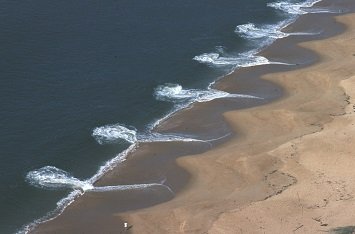April 2014 (ROTM#64) Pearl Beach, NSW Central Coast, Australia
While there are different types of rip currents, rip currents are most definitely NOT undertow. Rip currents do not pull people under, they just take them for a ride. But the term ‘undertow’ is almost always associated with rips. Well, maybe it’s because of some smaller rips called ‘swash rips’. Swash is a term used to describe the combination of the uprush of water up a beach once a wave has finally broken and its associated backwash down the beach.
Well, sometimes that backwash can be pretty strong and can knock people over and drag them offshore a bit. This is more likely to happen on steep beaches with beach cusps. Beach cusps are crescentic features with higher horns that have coarser sand/sediment and deeper embayments with finer sediments. Where they occur (generally on steeper beaches) they tend to be spaced pretty regularly along a beach. Beach cusps can be tiny, just cm’s apart, or tens of metre’s apart. In the case of larger cusps, the backwash caused by big waves can create reasonably strong, but short-lived rips that go just beyond the shoreline. However, to a non-swimmer, that can be dangerous.
I actually think the act of getting knocked over and pulled out has generated the sensation of being pulled under and hence being caught by the ‘undertow’. They are definitely a totally different type of rip. This picture is from Pearl Beach on the NSW Central Coast, just north of Sydney. It’s a classic steep and reflective beach with beach cusps and while not really dangerous, you can clearly see the clouds of sand (the swash rips) regularly spaced down the beach. They’d last for a few seconds every time there’s a big backwash.
Picture courtesy of Professor Andy Short from the University of Sydney - the only person on the planet who has visited every single beach in Australia!
Swash rips

